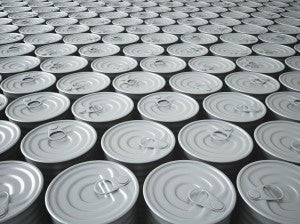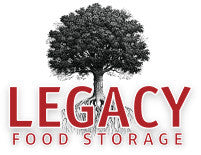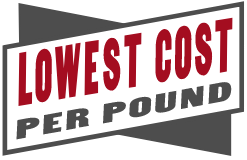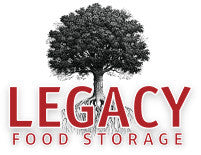
The Ten Rules of Emergency Food Storage
If you are in the process of putting away food storage to prepare for emergencies, chances are at some point in the process, you have or are going to feel overwhelmed by the task before you. Planning for unknown circumstances is always a challenge, and to top it off, there is a variety of (often conflicting) information in the food storage world about what and how to store your emergency food. Before you get too frustrated and give up, take a look at the most important rules of emergency food storage.
1. DO SOMETHING. When we have a big task before us, sometimes we can feel so overwhelmed that we stop before we even get started. When it comes to gathering food storage, it can feel like an impossible goal to get enough food stored away to feed a family for several days, let alone months or longer. Too many people let the size of this goal scare them into putting their emergency preparedness off for another time. But now is truly the only time we have to prepare. And storing even small amounts of food storage is better by a mile than storing nothing at all. So do something right now, today, that will make you better prepared. Whether it’s buying extra canned food at the grocery store, ordering some food storage samples, or canning your own goods, whatever you can do, do it now.
2. MAKE A PLACE FOR IT. Make a place for your food storage both in your home and in your budget. Neither of these is as hard as it initially seems. Emergency food can be stored almost anywhere in your home; you are only limited by your creativity. How about adding risers to your beds so that you can fit more food storage under them? Or adding a long table cloth to a table so that food storage can fit underneath without being seen? Other ideas: in window seats, in secret compartments on the wall behind pictures or mirrors, or in the tops of bedroom closets.
As far as fitting money for food storage into your monthly budget, anything you can spare will be worth it. Even if you’ve got ten or twenty dollars extra a month, you can use that to buy a few extra cans of something your family likes when you see it on sale. Even better, you can save up your monthly food storage allotment to buy bulk food storage items that will last in storage for long periods of time.
3. STORE FOOD YOU EAT. This rule of emergency food storage might seem like a no-brainer, but its importance necessitates our listing it. Too often, well-intentioned emergency preppers stock up on foods that their family has never actually eaten. (Ten gallons of whole wheat berries, anyone?) Then an emergency situation arrives, and they either have no idea what to make from their food storage, or they make it and find they can’t stomach it. Or even worse, their kids can’t stomach it. Surviving emergency situations well is all about maintaining as much normalcy as possible. When everything else is scary and unknown, mealtime is not the time to introduce new foods. For all of these reasons, it’s important to store food that your family already eats and enjoys. If this means mac and cheese and ramen noodles, so be it.
4. SAMPLE, SAMPLE, SAMPLE. We can’t overstate the importance of buying emergency food that your family likes. If you have emergency food stored that tastes like cardboard, your family is not going to eat it. Take advantage of all the sample options food storage companies provide. Try them out on your family to see whether your kids will actually eat them or not. Legacy Premium offers a variety of sample packs that are not only hearty and nutritious, but also very tasty. Do your research before you make any big purchases you might regret later.
5. EAT THE FOOD YOU STORE. Once you choose the types of food you are going to store long-term, it’s important to cook with those foods often. Regularly practice making different meals with the food storage you have on hand. This will ensure your family is used to the things you have stored, and it will also ensure that you know what to do with it.
6. VARY YOUR FOOD STORAGE. One mistake first-time preppers often make is to buy a large quantity of two or three items in bulk and then call it good. Think about the variety of foods you eat during a typical week. In an emergency situation, things will be a lot more pleasant for your family if you aren’t stuck eating canned chili or boiled rice for every single meal. You might be able to survive on this, sure, but thrive? Not so much. Start by stocking up on staples, and then add sides and snacks as you go along to be sure you have a wide array of foods to nourish your body during emergencies.
7. DON’T FORGET THE BASICS. Along with all of your other food storage, don’t forget to have extras of the flours, spices, and oils you frequently use in your cooking. Things like baking soda, salt, cinnamon, and other similar items are commonly forgotten in food storage, but they make cooking a whole lot easier when other supplies are low.
8. GROW YOUR OWN. Having a bountiful garden that will supplement your food storage with fresh, healthy produce is an important part of preparing for emergencies. In survival situations, our bodies need all the nourishment they can get. At the end of your growing season, save and store your seeds to guarantee you’ll have fresh food next year as well.
9. STOCK UP ON TREATS. Whether your treat of choice is peppermint patties, potato chips, or plain old chocolate, make sure to add a few bags to your food storage. In everyday life, most people like to indulge in treats at some point during the day. In an emergency situation, the high stress can make treats even more desirable. Having something for yourself and your family to munch on can help you feel more positive about whatever situation you find yourself in and less like you are simply surviving.
10. LABEL EVERYTHING. It’s easy to make a purchase of emergency food, toss it in the pantry, and then find yourself a few months or years later wondering how long you’ve had it and whether it’s still good. Labelling everything in your food storage pantry eliminates this problem. Keep a pen and some tape near your food storage and make a habit of labelling food with its purchase date every time you add to the pantry. Then put all of your most recent food storage purchases to the back of the pantry and move older items up to the front to facilitate rotation.
Despite the abundant and often conflicting information to be found about storing food for emergencies, it doesn’t have to be a difficult or gargantuan task. Following these tips for emergency food storage can help you to avoid some of the common mistakes of first-time preppers and get you on your way to true preparedness and its resulting peace of mind.
The post The Ten Rules of Emergency Food Storage appeared first on Buy Emergency Food.
Tags
- All
- 25 year food
- 25 year shelf life food
- 72 hour kit
- Best food storage types
- Best long-term food storage
- Blizzard preparedness
- Budgeting
- canning
- Certified GMO-free Emergency foods
- Certified GMO-free foods
- Coffee
- Comparison of emergency food methods
- Composting tips
- Dangers of genetically modified foods
- dehydrated food
- Edible Wild Plants
- emergcy preparedness
- Emergency Cooking
- Emergency Food
- Emergency food Christmas gifts
- emergency food storage
- Emergency Food Supply
- Emergency food supply recommendations
- Emergency Planning
- Emergency Preparedness
- Emergency preparedness advice
- emergency preparednesss
- Emergency Supplies
- Emergency supplies checklist
- Emergency Survival
- emergency survival gear
- Emergency survival kit checklist
- Emergency Survival skills
- exercise
- Family emergency preparedness
- Family emergency preparedness plan
- Family Preparedness
- Food Storage
- Food storage 25 year shelf life
- Food storage amounts
- Food storage Christmas
- Food storage containers long term
- Food Storage Secrets
- Food storage serving size
- Food storage types compared
- freeze dried food
- Freeze dried food storage
- freeze dried meats
- Freeze-dried emergency food storage
- Fruit Trees
- Gardening
- Getting Started
- Gluten-free food Storage
- Gourmet emergency food
- Healthy food storage
- How much emergency food to store
- Improved emergency preparedness
- Jared Markin
- Jared Matkin
- Legacy Premium
- Lessons learned from Hurricane Sandy
- Lessons learned from natural disasters
- long-term food storage
- Long-term Food Storage Guidelines
- Long-term Food Storage tips
- Long-term water storage
- Mental Emergency Preparedness
- Mental toughness
- Money-saving tips
- Natural disaster planning
- Natural Disasters
- Perfect Christmas gifts
- Pet Emergency preparedness checklist
- Pet Emergency preparedness kit
- Pet Emergency Survival tips
- Pets and Emergency Preparedness
- Plant Foraging
- portable solar panels
- portable solar power
- portable water filters
- protein drinks
- Risk of genetic modification
- Seed saving and storage
- Seed saving guide
- Self-reliance
- Self-reliant practices
- Shelf Life
- Solar Cooking
- Solar Ovens
- Special Dietary needs
- Stranded in a car in a blizzard
- Survival food
- Survival Gear
- survival kit
- Survival kits
- Survival Ovens
- Survival Skills
- survivalist gear
- suvival kit
- Tree Pruning tips
- Tree Trimming basics
- unique ideas
- water bottle with filter
- water filter
- water filter straw
- water filters
- Water Filtration
- water pitcher with filter
- water pitchers with filters
- Water purification
- Wild Food Foraging
- Winter composting
- Winter driving
- Winter preparedness tips
- Winter storm preparedness tips
- Winter Survival








